Rome is filled to the brink with awesome architecture and amazing art that you can stroll around and enjoy for free. But if you find the churches too crowded, the museums too overwhelming and the urban city too loud, perhaps you just need the meditative silence of a beautiful old library.
These antique rooms are not only a worthy refuge for ancient manuscripts and rare book collections, they are also a time machine into a bygone era of religious institutions and distinguished scholars such as Galileo Galilei. When you walk past the celestial globe of Accademia Nazionale dei Lincei, perhaps Albert Einstein, who was a member of the academy, admired it too. And when you stand in the imposing Biblioteca Vallicelliana, imagine how the Baroque architect Borromini thought out the plans for the beautiful edifice.
Whether the rooms are Renaissance or Baroque, of religious or secular origin, they are all beautiful containers of centuries of wisdom and creativity. Every architect of every one of these libraries had a vision of presenting the books in the most beautiful way possible. And they all succeeded.
Biblioteca Casanatense
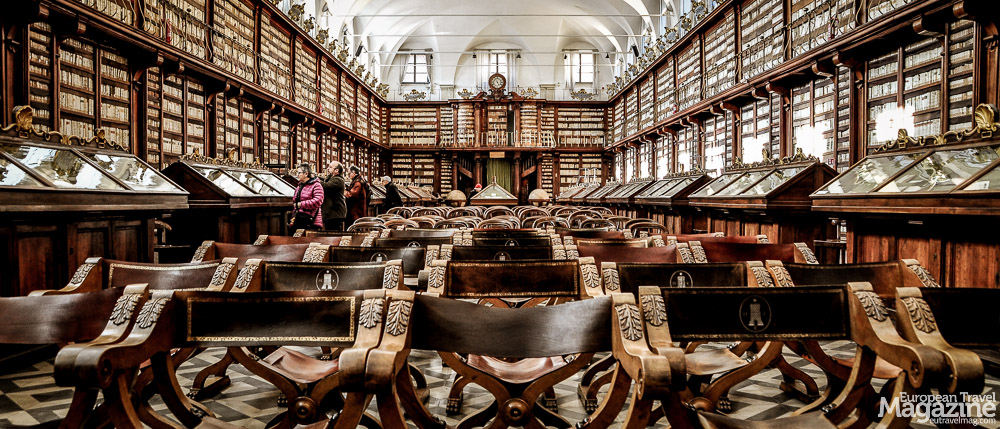
If you can visit only one library while in Rome, this monumental book room should be on the list. Not only is the Ancient Hall free to visit and open to the public Monday to Friday from 11.30 to 13.00, they have a selection of books on display in the many showcases.
The library was inaugurated back in 1701 and owes its birth to cardinal Girolamo Casanate (1620-1700) who bequeathed his 25.000 volumes of books to the Dominicans of the Convent of Santa Maria sopra Minerva provided that the library would be open to the public. It was – and still is to this day,
He left not only a lot of books, but also a huge sum of money to run the library and buy more books. In addition to the library staff he also provided for a college (theologi casanatenses) of six Dominicans of different nationalities (Italian, French, Spanish, German, English and Polish) that each had a doctorate from a European University. Aided by the resources of the library, they were to devote themselves to the defence and propagation of Catholic doctrine.
The library was linked to the most important european centres of book commerce, and it was interested both in modern production and antique books, with the aim of being an encyclopaedic library. Purchasing wasn’t limited to traditional religious and theological subjects, but also Roman law, economy, and history of the city of Rome.
- If you can visit only one library while in Rome, this monumental book room should be on the list
- The library was inaugurated back in 1701
- The library owes its birth to cardinal Girolamo Casanate (1620-1700)
- Cardinal Casanate bequeathed his 25.000 volumes of books to the Dominicans of the Convent of Santa Maria sopra Minerva, provided that the library would be open to the public
- He left not only a lot of books, but also a huge sum of money to run the library and buy more books
- Six Dominicans of different nationalities (Italian, French, Spanish, German, English and Polish) that each had a doctorate from a European University, were to devote themselves to the library and the catholic doctrine
- The Library was linked to the most important european centres of book commerce
- Purchasing wasn’t limited to traditional religious and theological subjects, but also Roman law, economy, and history of the city of Rome
- The terrestrial and celestial globes date back to 1716 and are typical of a renaissance library
- Not only is the Ancient Hall free to visit and open to the public, they have a selection of books on display in the many showcases
- After the pope lost his temporal power over Rome in 1870, the library was nationalized, but the Dominicans were left in charge until 1884
- Today, the library contains approximately 400.000 volumes of books
After the pope lost his temporal power over Rome in 1870, the library was nationalized, but the Dominicans were left in charge until 1884. Today, the library contains approximately 400.000 volumes. About 60.000 of these continue to be located in the so-called Salone Monumentale, or Ancient Hall, that is open to the public.
- Biblioteca Casanatense website
- Biblioteca Casanatense Facebook page
- Biblioteca Casanatense on Wikipedia
Biblioteca Angelica
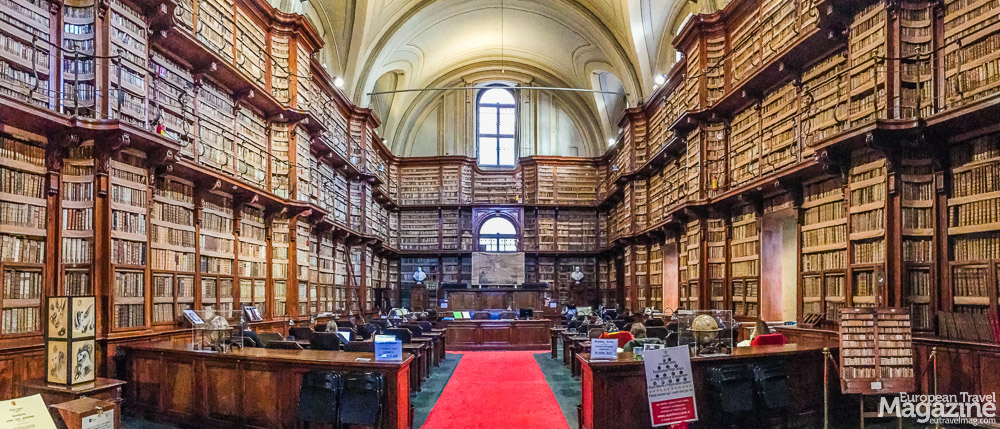
While any librofile will hear the angels sing when entering this grand space, it’s not the heavenly choir that has christened Biblioteca Angelica.
It was an Augustinian bishop by the name of Angelo Rocca that founded the library back in 1604, making it the second oldest library in Italy open to the public. Before that, only private libraries or convent libraries were accessible to the invited or initiated, but Angelo Rocca donated his own 20.000 manuscripts to the existing Augustinian library, found a suitable building and provided an annuity for its upkeep.
He wanted the library to be open to everyone regardless of their income and social standing. The uniqueness of this institution gave rise to an ever-increasing interest by the general public and soon the library’s fame spread to scholars all over the world.
Over the next centuries the library collected books on the thoughts of St. Augustine and the activities of the Augustinian Order, and the largest section of the collection include works on the Reformation and the Counter-Reformation with particular reference to Italy.
- While any librofile will hear the angels sing when entering this grand space, it’s not the heavenly choir that has christened Biblioteca Angelica
- It was an Augustinian bishop by the name of Angelo Rossa that founded the library back in 1604
- Biblioteca Angelica is the second oldest library in Italy open to the public
- Founder Angelo Rossa donated his own 20.000 manuscripts to the existing Augustinian library
- The library is housed in the former convent of the Augustinian Fathers, at the Church of Sant’Agostino in the historical centre of Rome
- Over the next centuries the library collected books on the thoughts of St. Augustine and the activities of the Augustinian Order
- Angelo Rocca wanted the library to be open to everyone regardless of their income and social standing
- The awe-inspiring reading room, the so-called Salone Vanvitelliano, is surrounded by a high wooden shelving by Nicola Fagioli
- The library holds around 200.000 volumes of manuscripts
- From the very beginning and up until today, the library is open to the public and free to enter
The library is housed in the former convent of the Augustinian Fathers, at the Church of Sant’Agostino in the historical centre of Rome. The current accommodation dates back to the mid-18th century when architect Luigi Vanvitelli was commissioned to renovate the entire convent. The awe-inspiring reading room, the so-called Salone Vanvitelliano, is surrounded by a high wooden shelving by Nicola Fagioli and holds approximately 100.000 volumes of the so-called Ancient Fund.
The library holds around 200.000 volumes of manuscripts, and to this day the library remains open to the public 6 days a week. If you want to study some of the manuscripts, you have to be over the age of 16 and must present some ID, but as a tourist you can visit the outer perimeter of the reading room for free to quietly take in the ambience of this room of enlightenment.
Biblioteca di Archeologia e Storia Dell’Arte

The Library of Archeology and Art History is located in two places: at the first floor of Palazzo Venezia in Piazza Venezia, and in the Sala Crociera at the former Collegio Romano next to the church of Sant’ Ignazio di Loyola. While the former is a great place to study, the latter is the epitome of a classic library. Filled with books donated by archaeologists, scholars and art historians, this stunning library will take your breath away.
The Sala Crociera formed part of the Roman College, a Jesuit institution that commissioned and occupied the buildings from 1584 and right up to the time of Italy’s reunification in 1870. The Jesuits were – like most other religious institutions – closed by the government, who took over the edifice. The library collection was transferred to Biblioteca Nazionale Vittorio Emanuele III in Naples in 1873 and the Sala Crociera was turned into the National Library in 1876. When the National Library moved to its present location at Via Castro Pretorio in 1975, the historical rooms were just waiting for another dignified party to take over. This happened in 1986 when the Biblioteca di Archeologia e Storia Dell’Arte was assigned the fitting rooms of Sala Crociera and moved its main fund into these amazing accommodations.
It’s strange to think about the turbulent life of both the chambers and the collection of books when they both come so brilliantly together. It’s like the 17th century wooden shelvings have always carried these volumes and they certainly look dashing in these worthy surroundings.
- The Sala Crociera at the former Collegio Romano
- This is the epitome of a classic library
- Filled with books donated by archaeologists, scholars and art historians, this stunning library will take your breath away
- The Sala Crociera is open to the public on Wednesdays and Thursdays
- The library’s total documented heritage is estimated at around 380.000 volumes
- Check out the many different labels on the books, testifying to the collection’s diverse history
- The Sala Crociera formed part of the Roman College, a Jesuit institution that commissioned and occupied the buildings from 1584
- The ancient books certainly look dashing in these worthy surroundings
- Biblioteca di Archeologia e Storia Dell’Arte was assigned the fitting rooms of Sala Crociera in 1986
- It’s strange to think about the turbulent life of both the chambers and the collection of books when they both come so effortlessly together
- These antique rooms are not only a worthy refuge for ancient manuscripts and rare book collections
- It’s like the 17th century wooden shelvings have always carried these volumes
- Whether the libraries of Rome are Renaissance or Baroque, of religious or secular origin, they are all beautiful containers of centuries of wisdom
The library’s total documented heritage is estimated at around 380.000 volumes, 3.500 magazines, 20.700 units of graphic material (engravings, drawings, photographs), 2.000 theatre posters, 66.000 microfiches and something so un-archaeological as 400 CD-ROMs. The Sala Crociera is open to the public on Wednesdays from 9.30 to 17.00 and on Thursdays from 9.30 to 13.30 provided you can present a valid ID and are at least 19 years of age.
When you have caught your breath after the breathtaking encounter with the magnificent rooms, stroll around to check out the many different labels on the books, testifying to the collection’s diverse history, many donations and accumulated heritage.
- Biblioteca di Archeologia e Storia Dell’Arte website (In Italian)
- Biblioteca di Archeologia e Storia Dell’Arte on Wikipedia (In Italian)
- Collegio Romano on Wikipedia
Accademia Nazionale dei Lincei

The full name of this library is Biblioteca dell’Accademia Nazionale dei Lincei e Corsiniana and is a fusion of the library of the Lincei Academy dating back to 1603, and the private library of the Corsini family, which was bequeathed to the academy when the Italian government bought the Corsini Palace, the present address of the academy, back in 1883.
Accademia Nazionale dei Lincei is named after the lynx and was founded in 1603 by the only 18-year-old aristocrat Federico Cesi and other illustrious personalities of the 17th century culture: Dutch physicist Johannes van Heeck, Italian mathematician Francesco Stelluti and polymath Anastasio de Filiis. Galileo was accepted into the exclusive academy in 1611 and quickly became its intellectual centre. Galileo clearly felt honoured by his association with the Lincei Academy, for he chose Galileo Galilei Linceo as his signature. The academy published his works and supported him during his disputes with the Roman Inquisition. After Cesi’s death in 1630 the academy closed, was reopened in 1801, only to close in 1840 and finally reopen in 1847. Much of the library collection from the original academy was destroyed, auctioned off or lost in a shipwreck.
In 1887 the academy moved to the Corsini Palace, and the library of Corsini became the backbone of the academy’s book collection. It contains the first books purchased by Lorenzo Corsini, then Pope Clement XII, before and after his pontificate in the 18th Century. A bust of him presides at the end of the library hall, and so he still watches over his literary legacy. The Corsini family continued to expand the collection, and Cardinal Neri Maria Corsini opened the library to the public in 1756.
Today, the library holds many hundred thousand volumes and is still open to the public, Monday to Friday except in August. It also provides a local, national and international library loan service and has launched a wide digitization campaign of old catalogues.
- The full name of this library is Biblioteca dell’Accademia Nazionale dei Lincei e Corsiniana
- It is a fusion of the library of the Lincei Academy dating back to 1603, and the private library of the Corsini family.
- The Italian government bought the Corsini Palace, the present address of the academy, back in 1883
- A bust of Lorenzo Corsini presides at the end of the library hall, and so he still watches over his literary legacy
- Today, the library holds many hundred thousand volumes and is still open to the public, Monday to Friday
- Galileo Galilei was accepted into the exclusive academy in 1611 and quickly became its intellectual centre
- When walking through the many library rooms, you realise the vast heritage of this esteemed library
- When you enter the library’s reading room you are taken aback by the dazzling frescoes and golden ornamentation beaming back at you
- The Corsini family continued to expand the collection, and Cardinal Neri Maria Corsini opened the library to the public in 1756
- When visiting the library, you enter the former palace of the Corsini family, beautifully furnished and impeccably kept
When visiting the library, you enter the former palace of the Corsini family, beautifully furnished and impeccably kept. The huge building also features the delightful art museum Corsini Gallery and the palace gardens form part of the Rome’s Botanic Garden. When you enter the library’s reading room you are taken aback by the dazzling frescoes and golden ornamentation beaming back at you. When continuing through the many rooms, you realise the vast heritage of this esteemed library and are grateful that the two libraries “found each other” and capable librarians continue to protect, expand and share its patrimony.
- Accademia Nazionale dei Lincei website
- Brochure about the Library of Accademia Nazionale dei Lincei and Corsiniana
- Accademia Nazionale dei Lincei on Wikipedia
Biblioteca Vallicelliana
When you walk across Piazza della Chiesa Nuova towards the pale travertine church of Santa Maria in Vallicella, also called Chiesa Nova meaning “New Church”, you head for the door just to the left of the church, in the creamy brown brick building of Casa dei Filippini or the House of the Oratorians, designed by Baroque architect Borromini and built between 1637 and 1667.
Finding your way in this labyrinthian complex is made easier by the information signboards in the courtyard, telling the history of the building and guiding your way to Borromini’s beautiful library. Ascending the staircase, you pass the Capitolino Historical Archives and a couple of huge plaster reliefs and finally reach Biblioteca Vallicelliana.
The library is open Monday to Friday and every other Saturday and is free to visit if you’re 16 years of age and can provide a valid ID. After disposing of your bag in the cloakroom, you can enter the imposing baroque library with its coffered ceiling and dark wooden shelves, intricately carved and beautifully lit.
Its heritage contains more than 130.000 volumes of manuscripts, pamphlets and books, and the library has continuously expanded its collection since founder Filippi Neri initiated in back in 1565. It features an important collection of about 3.000 Latin, Greek and Oriental manuscripts, some of great value and antiquity, such as the Alcuin Bible from the 9th century.
Contrary to many of the other libraries in Rome, Biblioteca Vallicelliana was not the library of a convent, but rather of a religious order called the The Congregation of the Oratory. Unlike a religious institute where the members take vows, the Oratorians are made up of members who commit themselves to membership. The Oratorians had a particular attention to books because their meals were accompanied by reading and discussion of a religious text.
- Biblioteca Vallicelliana is located in the wonderful Casa dei Filippini, designed by Baroque architect Borromini in the mid-17th Century
- After disposing of your bag in the cloakroom you can enter the imposing Baroque library
- Its heritage contains more than 130.000 volumes of manuscripts, pamphlets and books
- Study the celestial and terrestrial globes. There are so many details to cherish in this Baroque library, so take your time to take it in
- The library has a coffered ceiling and dark wooden shelves, intricately carved and beautifully lit
- Stop to appreciate the book collection of Filippo Neri himself
- The library features an important collection of about 3,000 Latin, Greek and Oriental manuscripts
- Admire the frescoes on the ceiling, the craftsmanship in the woodwork and the wonderful old volumes of books
- Contrary to the many other libraries in Rome, Biblioteca Vallicelliana was not the library of a convent, but rather of a religious order called the The Congregation of the Oratory
- The bust of Filippo Neri himself
- The library is open Monday to Friday and every other Saturday and is free to visit
When walking through the library, admiring the frescoes on the ceiling, the craftsmanship in the woodwork and the wonderful old volumes, stop to appreciate the book collection of Filippo Neri himself. Find his bust. Study the celestial and terrestrial globes. There are so many details to cherish in this Baroque library, so take your time to take it in.
If you want to discover more about Rome, how about a free, self guided tour through the streets and into some wonderful churches in the Footsteps of Robert Langdon: Among Angels and Demons. Or if you’re keen on travelling further back in history, check out our guide to the best historical Roman sites In the Footsteps of the Romans – Rome.
Learn more
Discover more
Get under the skin of Rome by staying here a bit longer than just one week. We can strongly recommend Crib Med for medium-term rentals in the eternal city.


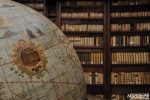

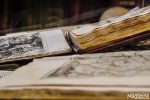



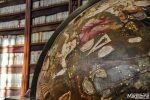
























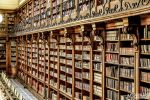
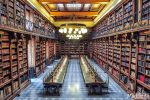

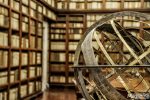

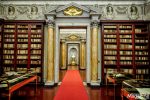




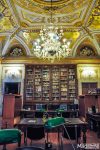








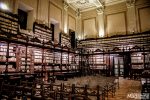

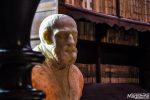





It must be a challenge to preserve and maintain these thousands of old and ancient books. I suspect they focus on the most “valuable” ones, leaving thousands still to just sit mouldering in cases in rooms without climate control, for “visual effect”.
Yes, I think you’re right it’s a challenge. Most of the rooms of the libraries however WERE climate controlled so I believe they are handling them alright..